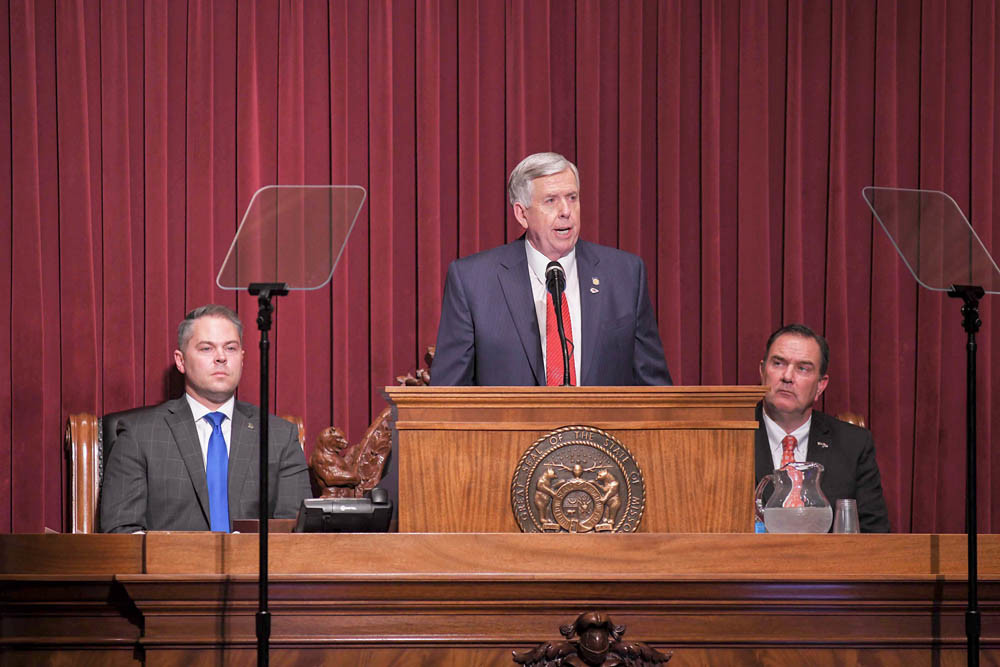YOUR BUSINESS AUTHORITY
Springfield, MO
YOUR BUSINESS AUTHORITY
Springfield, MO

Delivering his first State of the State address Jan. 15 in Jefferson City, Gov. Mike Parson said he wants to spend nearly $75 million to advance job-training opportunities for Missouri workers.
The workforce development programs are part of the governor’s proposed $30 billion budget for fiscal 2020, which also includes a $351 million bond package proposal to improve state bridges.
“Cultivating and training our workforce for high-demand jobs and investing in critical infrastructure are the priorities we must address this session,” Parson said before a joint session of the General Assembly.
Parson acknowledged past transportation funding proposals going before the voters and failing – most recently a November 2018 defeat of a 10-cent increase to the state’s gas tax, for which he openly campaigned and supported. He told legislators it doesn’t mean additional efforts to bolster the infrastructure should be avoided.
“This is why I am asking you to consider an infrastructure plan,” Parson said. “While funded through our budget savings, it will give us the ability to begin immediate work on nearly 250 bridges across the state of Missouri – all in need of critical repair or replacement.”
Key expenditures in the workforce development plan are $22.2 million to the Fast Track workforce incentive grant program, $10 million for Missouri One Start to provide training for new and expanding businesses and $16.3 million for Missouri Excels to expand employer-driven higher education and training.
While at the Discovery Center of Springfield on Jan. 18 announcing tax credits through the Neighborhood Assistance Program, Parson said Fast Track targets people who are 25 and older with an average household income of $80,000 or less. Grants will be available to cover full tuition and fees for up to four semesters.
“What we’re wanting to do is to get them to go back and pick up some sort of post-secondary education, whether it’s some sort of skill, apprentice training at community colleges, tech schools or a university,” he said.
Shared priorities
Reps. Elijah Haahr, R-Springfield, and Crystal Quade, D-Springfield, also were on hand at the Discovery Center, and each generally had positive takeaways from the governor’s first State of the State.
“Each one of the programs he’s laid out in the workforce development space was what I consider a priority,” Haahr said, noting in his six years as a state representative, there hasn’t been a big focus on workforce. “We’ll do more on workforce development this year than we’ve done in the last 20 years combined.”
Haahr said some of the governor’s proposals, such as Fast Track, are among prefiled bills in the House that were referred to the workforce development committee.
Quade said she’s been a big supporter of Missouri Works, which is part of the Missouri One Start program under the governor’s proposed budget. While glad to hear about a $10 million planned investment in that program, Quade said she wants to make sure any new initiatives, particularly those involving higher education, aren’t coming at the expense of others.
“New programs are wonderful and I hope we can get them done, but we need to make sure the structural programming exists for both Missouri State [University] and (Ozarks Technical Community College) and are funded as well,” Quade said.
Haahr and Quade said on Jan. 18 they were still processing the governor’s proposed budget, which they just received two days prior. Both local representatives are in new leadership positions – Haahr as speaker of the House and Quade as House minority leader.
It’s clear to them that OTC’s $10 million funding request for its Center for Advanced Manufacturing and Technology is a high priority.
“We’re definitely going to push for that, and I believe that falls right in line with the governor’s workforce development agenda,” Quade said.
OTC Chancellor Hal Higdon said $5 million for the center was included in the governor’s budget proposal, adding the college intends to submit another $5 million request for the 2020 legislative session.
“I see that as a unifying project,” Higdon said, adding he expects the funding request will be part of the final approved budget in the spring.
If the request is approved by the legislature, he said funds would be available by July.
Additional funding for the estimated $20 million center will be sought by OTC, Higdon said, including private and federal grants, private donations and corporate sponsorships.
Cost concerns
As she prepared to dig more deeply into the budget, Quade said her biggest concern is finding funds for all of the proposed expenditures. She pointed out that bonding, such as the package sought for improving state bridges, is “essentially a credit card for the state of Missouri.”
“Those types of conversations do make me nervous when it comes to looking at the budget and all these wonderful new programs that we need to do,” she said of funding concerns. “Where is it going to come from?”
As he awaits the legislature’s decision on the budget before session’s end in May, Parson said he’ll emphasize the workforce development programs. While state unemployment is low – currently 3.1 percent, according to the Missouri Department of Economic Development – he said businesses need to be able to find qualified workers to meet demand.
“There’s a tremendous opportunity right now in the state of Missouri,” he said. “If we can get people qualified to get them the schooling they need, the workforce demand is out there. That’s really where all that focus is going.”
Haahr agreed a more qualified workforce is paramount to the state’s economic development.
“What we need to do is start turning out the people,” he said. “In Springfield, we have 3 percent unemployment and 20 percent poverty. It means we’ve got jobs, but they need better jobs. We’ll get those better jobs if we start turning out those better employees.”